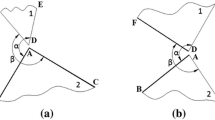Abstract
Discontinuous deformation analysis (DDA) method is a newly developed discrete element method which employs the implicit time-integration scheme to solve the governing equations and the open-close iteration (OCI) method to deal with contact problem, its computational efficiency is relatively low. However, spherical element based discontinuous deformation analysis (SDDA), which uses very simple contact type like point-to-point contact, has higher calculation speed. In the framework of SDDA, this paper presents a very simple contact calculation approach by removing the OCI scheme and by adopting the maximal displacement increment (MDI). Through some verification examples, it is proved that the proposed method is correct and effective, and a higher computational efficiency is obtained.
Similar content being viewed by others
References
Cundall P A. A computer model for simulating progressive large scale movements in blocky rock system. In: Proceedings of the Symposium of International Society of Rock Mechanics. Nancy, 1971. 1: II–8
Shi G H. Discontinuous deformation analysis: A new numerical model for the statics and dynamics of block systems. Dissertation for Doctoral Degree. Berkeley: University of California, 1988
Jiao Y Y, Zhang X L, Zhao J. Two-dimensional DDA contact constitutive model for simulating rock fragmentation. J Eng Mech-ASCE, 2012, 138: 199–209
Jiao Y Y, Zhang H Q, Tang H M, et al. Simulating the process of reservoir-impoundment-induced landslide using the extended DDA method. Eng Geol, 2014, 182: 37–48
Jiao Y Y, Zhang H Q, Zhang X L, et al. A two-dimensional coupled hydromechanical discontinuum model for simulating rock hydraulic fracturing. Int J Numer Anal Meth Geomech, 2015, 39: 457–481
Zheng H, Jiang W. Discontinuous deformation analysis based on complementary theory. Sci China Tech Sci, 2009, 52: 2547–2554
Yeung M R, Jiang Q H, Sun N. A model of edge-to-edge contact for three-dimensional discontinuous deformation analysis. Comput Geotech, 2007, 34: 175–186
Jiang Q H, Yeung M R. A model of point-to-face contact for three-dimensional deformation analysis. Rock Mech Rock Eng, 2004, 37: 95–116
Wei W, Jiang Q H, Jun P. New rock bolt model and numerical implementation in numerical manifold method. Int J Geomech, 2016, doi: 10.1061/(ASCE)GM.1943–5622.0000669
Zhang H, Chen G Q, Zheng L, et al. Detection of contacts between three-dimensional polyhedral blocks for discontinuous deformation analysis. Int J Rock Mech Min, 2015, 78: 57–73
Zhang H, Liu S G, Zheng L, et al. Extensions of edge-to-edge contact model in three-dimensional discontinuous deformation analysis for friction analysis. Comput Geotech, 2016, 71: 261–275
Shi G H. Contact theory. Sci Chnia Tech Sci, 2015, 58: 1450–1496
Zhao S L. Development of three dimensional spherical discontinuous deformation analysis for granular materials. Dissertation for Doctoral Degree. Raleigh: North Carolina State University, 2000
Beyabanaki S A R, Bagtzoglou A C. Three-dimensional discontinuous deformation analysis (3D DDA) method for particulate media application. Geomech Geoeng, 2012, 7: 239–253
Jiao Y Y, Huang G H, Zhao Z Y, et al. An improved three-dimensional spherical DDA model for simulating rock failure. Sci Chnia Tech Sci, 2015, 58: 1533–1541
Khan M S, Riahi A, Curran J H. Effects of time-step size on the efficiency of discontinuous deformation analysis. In: Kanjlia V K, ed. In: Proceedings of ISRM International Symposium 2010 and 6th Asian Rock Mechanics Symposium. New Delhi: Isrm International Symposium, 2010
Cheng Y M. Advancements and improvement in discontinuous deformation analysis. Comput Geotech, 1998, 22: 153–163
Jiang Q H, Chen Y F, Zhou C B, Yeung M R. Kinetic energy dissipation and convergence criterion of discontinuous deformation analysis (DDA) for geotechnical engineering. Rock Mech Rock Eng, 2013, 46: 1443–1460
Quinn M J. Parallel Programming in C with MPI and OpenMP. New York: McGraw Hill, 2003
Author information
Authors and Affiliations
Corresponding author
Rights and permissions
About this article
Cite this article
Wang, L., Jiao, Y., Huang, G. et al. Improvement of contact calculation in spherical discontinuous deformation analysis. Sci. China Technol. Sci. 60, 765–771 (2017). https://doi.org/10.1007/s11431-016-0203-6
Received:
Accepted:
Published:
Issue Date:
DOI: https://doi.org/10.1007/s11431-016-0203-6




